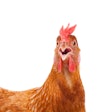For most farmers, stewardship of the land is in their blood, and this is certainly the case for third-generation layer pullet grower Bill Knapke. He and his wife, Janet, own and operate Meiring Poultry in Fort Recovery, Ohio. Bill’s grandfather, Herb Meiring, started the poultry operation in the 1950s. Knapke, who is environmental manager for Cooper Farms, took over the farm from his uncle, Jim Zehringer, who is director of the Ohio Department of Natural Resources.
The 250-acre row crop farm has four deep-stack, high-rise pullet houses and can raise 330,000 pullets per cycle. Corn and soybeans are raised on the farm, and pullet manure was utilized to fertilize the fields using a nitrogen-based manure management plan until the 1990s. Since the farm began using a phosphorous-based nutrient management system, all of the manure has been sold for use as a soil amendment on other crop farms. Knapke recently built a manure shed so that manure can be removed from the houses after each flock and stored under cover until planting season. Removal of the manure aids in ammonia control in the houses and allows for a more thorough clean up in between flocks.
Knapke sells his manure through a broker and gets approximately $25 per ton, or $500 for a semi load, for the manure. He said that the manure is usually hauled around 50 to 100 miles one way to customer fields.
To protect the land and water quality and preserve wildlife, Knapke has installed field borders, filter strips, wetlands, windbreaks and other general tree plantings around the farm. Meiring Poultry participates in the Conservation Reserve Program and the Wetlands Reserve Program.
Participating in research
Knapke said that it is common for row crop farmers in Ohio to drain their fields with perforated tiles placed 24 to 36 inches deep in the soil. The tiles drain off excess water from the field in the spring and the fall and allow farmers to get in the field earlier in the spring. “It improves your ability to grow crops,” he said.
The tiles are spaced 40 to 50 feet apart. Because of the amount of elevation change in his fields, the tiles do not have valves to stop drainage. Knapke said that in parts of Ohio that are flatter, they do have valves at the ends of the tiles to allow the farmer to retain moisture in the soil in the summertime.
Knapke is participating in USDA Agricultural Research Service and USDA National Resources Conservation Service research, which monitors the phosphorous levels in the drainage from his farm's fields. He has instituted no-till planting and use of field cover crops in the off-season as part of the experimental protocol. Two monitoring stations have been installed where runoff is collected, both from tile and surface runoff. The samples are analyzed to better understand the movement of phosphorous in the soil and the relationship to tillage and the use of cover crops. Knapke said that they may vary no-till versus tillage and the use of cover crops as part of future year’s data gathering. His cooperation in the project provides researchers with a real-life field trial.
Manure management
Drying out manure as it collects in the pit of the house is an important first step in controlling insects and reducing ammonia production. Ammonia volatilization can negatively impact bird health, be a nuisance to neighbors and it reduces the fertilizer value of the manure. Knapke, who has experience working with Cooper Farms’ swine operations, is using a polymer-based product (that can be used in liquid or dry manure) to reduce ammonia volatilization in his pullet houses and improve fertilizer value of the manure.
Knapke is spraying More Than Manure on the manure in the pit three times, or every five weeks, during the pullet growing cycle. He said that they have had lower ammonia levels in the building and that there seems to be a synergistic effect with the insecticide, which they apply at the same time. The polymer product prevents nitrogen being volatilized as ammonia, and it keeps the phosphorous in a plant available form. In addition to reducing in-house ammonia levels, Knapke hopes that the cost of the treatments will be more than offset by an increased selling price for the manure based on the higher nitrogen content and increased availability of the phosphorous.
Keeping busy
After graduating from college, Knapke was hired as a service person in Cooper Farms’ swine operations. In this role, he helped a number of producers compose their nutrient management plans. Eventually, he transitioned into doing environmental work for Cooper Farms fulltime, and then the opportunity presented itself to get more involved in the pullet operation and eventually take it over.
Knapke said that he has a hired man on the farm to do a lot of the work with the birds, but that he visits the birds twice a day in the morning and the evening and that his sons help out as well. As a former turkey serviceperson myself, I asked Knapke about his decision to purchase a poultry farm of his own, with all it entails, including around the clock responsibility. “You really have to have that in you naturally to want to do things like that, because it is 365 days a year for the most part. You don’t just turn out the lights and walk away. For those that enjoy this, it is wonderful, but it isn’t for everyone,” he said.
Meiring poultry has received environmental awards from the Ohio Poultry Association and the Ohio Livestock Coalition. The farm was named a 2013 Family Farm Environmental Award winner by the U.S. Poultry & Egg Association at the 2013 International Production and Processing Expo in Atlanta.
















